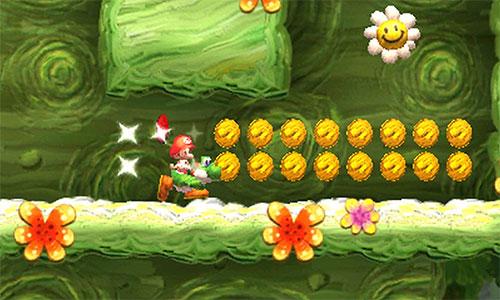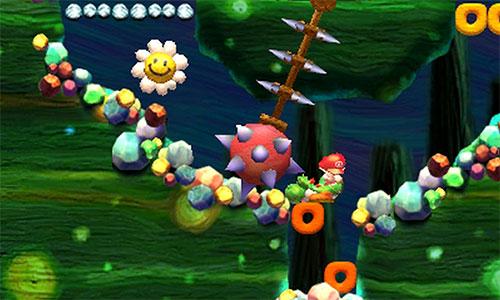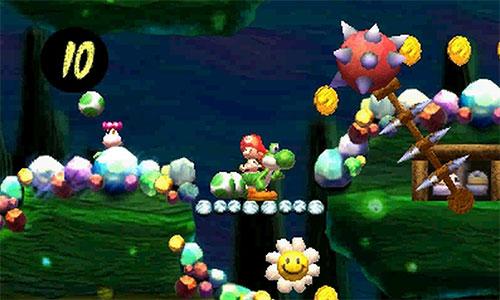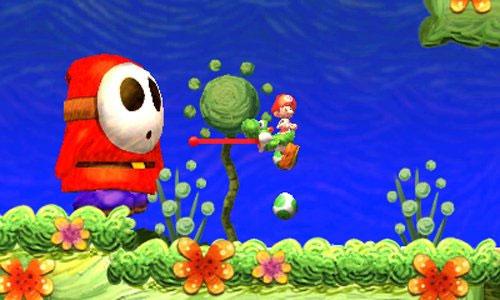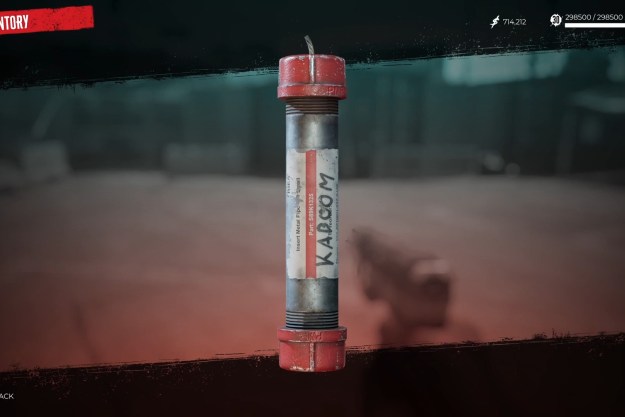
“Yoshi's New Island isn't the creative masterclass in platforming the original was, but it is the best platformer Nintendo's released for the Nintendo 3DS to date.”
- Solid, distinctive platforming
- Fetching visuals that shame other recent Nintendo throwbacks
- Fine-tuned difficulty
- Lullaby music could cure insomnia
- Irritating motion control vehicle stages
Yoshi’s New Island is a good game, even if it isn’t one that’ll change the world. From the moment you start, it feels effortless and breezy, even when it’s challenging. So breezy, in fact, that you find yourself forgetting that it ain’t easy out there for a Yoshi. The Dinosaur Island native has acquitted himself well in supporting roles. He’s been a reliable beast of burden in Super Mario World; a glutton in Yoshi’s Cookie; a bare-knuckle bruiser in Super Smash Bros.; and even a pretty capable wheelman in Mario Kart. When it comes to being a platformer star though, the little green blighter in the big brown boots has never quite come into his own.
The original Yoshi’s Island was a wash of crayon color and devious platforming, every level crammed with nail-biting jumps and hidden items to collect. In Yoshi’s New Island, though, the series has finally come home. It’s not the creative master class in platforming that the original was, but it is the best original game about jumping over stuff that Nintendo’s released to date for the 3DS.
As the title suggests, Yoshi’s New Island is a back-to-basics sequel in the vein of New Super Mario Bros. Kicking off in the exact same way as the SNES original, the good old stork is making baby deliveries – reproduction in the Super Mario universe apparently runs on 1950s storybook rules – and accidentally brings infant Mario and Luigi to the wrong parents.
Yoshi’s New Island is a back-to-basics sequel in the vein of New Super Mario Bros.
Worrying about massive human rights violations and losing his job, the stork takes off into the night but gets jacked by terrapin magician Kamek and his band of Shy Guys. They make off with Baby Luigi and head back to the evil Baby Bowser’s castle on Egg Island. Baby Mario crash lands in the middle of some Yoshis (Yoshae? Yoshai?), who kindly set out to reunite the brothers, destroying Kamek and Baby Bowser’s castles along the way.
The premise is as simple as the original Super Mario Bros.‘, and it’s not alone; the overall design screams ‘classic platformer’ at every turn. There are 48 levels (in addition to some hidden extras) spread across six worlds. You’ve got to get Yoshi to the end of the stage without dying, which means avoiding enemies and not falling into spikes, poison water, or a bottomless pit. In every fourth and eighth stage, you fight a boss.
There are, of course, some appropriately Yoshi twists. Never one to be caught unarmed, the green dino makes eggs – which double as projectiles – by swallowing enemies with his lengthy tongue and then spitting them out, to defeat enemies, clear obstacles, or collect coins and items. Yoshi can also float for a bit in mid-air if you hold down the jump button, a wonderfully tactile mechanic in the world of video game mobility.
Having to cart around little Baby Mario complicates matters. If some pesky Piranha fish or wispy wind spirit hits Yoshi, the babe gets knocked off his back. You’ve then got 10 seconds to pick Mario back up before Kamek’s minions fly off with him, costing Yoshi a life. Protecting the baby may be a holdover from the earlier game, but it remains an excellent twist on platforming even after 20 years. Surviving the stages is challenging enough, especially as you get into Yoshi’s New Island‘s latter worlds, but keeping baby Mario safe adds an additional layer of challenge to the usual reflex-based acrobatics of Nintendo platformers.
That’s only the start of Island‘s smart challenge layering. Each stage also hides 20 red coins, five smiley flowers to collect, and any number of stars, which are “spent” to extend the amount of time you can be separated from Baby Mario (you can store up to 30). All of these various collectibles function as a sort of organic difficulty slider; the more you go after, the tougher the challenge.
For the completionist, Yoshi’s New Island gets brutally difficult quickly, but the rewards for hunting down these collectibles are part of the fun. Finding hidden puzzle rooms with simple puzzles to solve, jumping in the air and revealing a hidden item you need to hit with an egg; the game hides myriad pleasures. Getting to the end of a stage and watching one Yoshi toss the baby to another while tallying a perfect score of coins, stars, and flowers is marvelously satisfying.
All of this was true of the original Yoshi’s Island, though New Island does distinguish itself from that classic. The lush, hand-drawn pixel art of the original is replaced here with three-dimensional polygons, like we’ve seen New Super Mario Bros. and The Legend of Zelda: A Link Between Worlds. New Island differs from those with its soft, painterly appearance that congeals nicely in the middle of the game. Stages in the third and fourth worlds veer from purple nighttime backdrops, to red and green brick sewers, to areas where the stage looks like a forest rendered in the muted blacks and whites of sumi-e ink drawings. The lethargic music doesn’t hold up to the classics, but New Island‘s certainly got the look.
[The collectibles] function as a sort of organic difficulty slider; the more you go after, the tougher the challenge.
More significant than aesthetics is the shift in perspective. Yoshi and Baby Mario are much bigger on the screen in New Island than they’ve been in the past. It makes the game feel overly cramped at first, though it quickly becomes clear that the levels are designed to account for the diminutive 3DS screen. The oversized Yoshi and Lone Cub don’t become a hindrance. If anything, the constraints that the more zoomed-in perspective place on level design makes New Island a touch easier than its ancestor. Secrets are more accessible, replays of levels are less taxingly drawn out. Diehard fans looking for the original’s punishment may be disappointed, but that’s the price of seeking a broader audience.
Less welcome are the new vehicle stages, which make the mistake of relying on motion controls. They’re faint echoes of similarly weird sections from the original game, but where they added variety to the classic, they bring only frustration here. They appear infrequently, but they’re not nearly as welcome as they were in the past. At least the weirdness remains: Turn Yoshi into a submarine and torpedo through bad guys or turn into a jackhammer and smash through rocks all before the timer runs out.
Unfortunately, the vehicle sections force you to use the 3DS’ gyroscopic sensor, which means you have to tilt the handheld back and forth to navigate. These sections aren’t just annoying; the very act of playing through them also necessitates turning off the handheld’s 3D feature, since the required jostling messes with the optical illusion. If you don’t like them, you’ll probably want to skip trying to collect all of the flowers, since your reward for that is an unlockable vehicle stage. Blech.
Yoshi’s New Island never rises above the game that inspired it. For better or worse, this is just an excellent iteration of a 20-year-old game. That’s a very good thing on the Nintendo 3DS, where the only major first-party competitors are New Super Mario Bros. 2 and Donkey Kong Country Returns 3D. The latter is a port and the former is a bore, making Yoshi’s New Island a mighty fine original. Will it make Yoshi the platforming champion we’ve always wanted him to be? Nope, but it’s nice to see him at least get back to where he started.
This game was reviewed on a Nintendo 3DS using a code provided by Nintendo.
Highs
- Solid, distinctive platforming
- Fetching visuals that shame other recent Nintendo throwbacks
- Fine-tuned difficulty
Lows
- Lullaby music could cure insomnia
- Irritating motion control vehicle stages
Editors' Recommendations
- Embracer Group just sold Saber Interactive. Here’s who still owns what
- Nintendo is shutting down online services for 3DS and Wii U next April
- WarioWare: Move It! brings 200 new microgames to Switch this November
- The best weapon mods and perks in Dead Island 2
- The best Skill Cards in Dead Island 2
